The choice between rectangular and circular clarifier basin configurations is a long-standing debate. Clarifiers are vital in separating particles from liquids in water and wastewater treatment processes, so the best choice is worth discussing.
In the early days of wastewater treatment plant designs in the United States, rectangular and circular options were considered relatively equal. For years, engineers and design companies leaned on past experiences and personal preferences to choose between clarifier shapes.
Later, with the advent of biological treatment, corrosion concerns due to collector or scraper systems designed from steel shifted the tide of popular opinion toward circular clarifiers.
In recent times, technological advancements, especially the introduction of non-metallic chain and flight systems, have sparked a resurgence in rectangular clarifiers, particularly for larger wastewater treatment plants.
Let’s delve into a comparative analysis of the benefits offered by each configuration, starting with performance.
Rectangular vs Circular Clarifier Performance
The shape of clarifiers alone does not significantly impact performance, provided they are well-designed. However, when we delve into the specifics, rectangular clarifiers showcase distinctive advantages.
A documented investigation by the Sanitation District of Los Angeles County (LACSD) highlights the effectiveness of shallow rectangular clarifiers (3m deep) with concurrent sludge removal. This design excels at a surface overflow rate (SOR) as high as 2000 gpd/ft2. Notably, the effluent suspended solids (ESS) concentration from the 3m rectangular clarifier matches the effectiveness of circular clarifiers with a depth of 5.5m.
That finding suggests that rectangular clarifiers can be constructed shallower to achieve equivalent effluent quality, leading to potential cost savings.
Clarifier Hydraulics
When it comes to clarifier hydraulics, the unique shape of rectangular clarifiers stands out from circular ones. Hydraulic retention time (HRT), or detention time, is essential in water and wastewater treatment, and that is extended with a rectangular design, compared to circular.
Rectangular clarifier configurations offer a longer path for wastewater flow, ensuring an extended HRT that minimizes short-circuiting and maximizes sludge settling, promoting the effective separation of solid particles. This optimizes contact time between water and treatment processes within the system, leading to more effective and thorough treatment. In the context of clarifiers, where the goal is to separate solids from liquids, a longer flow path contributes to improved performance and water quality.
This advantage becomes particularly evident when comparing it to the center-feed/peripheral overflow design of circular clarifiers. That design moves sludge faster at the perimeter of the collector than at the center, allowing the possibility of the resuspension of solids.
Moreover, the even flow distribution in rectangular clarifiers plays a pivotal role. It not only promotes efficiency but also demands less head loss, setting them apart from circular counterparts. This even distribution is particularly advantageous when multiple clarifiers are involved.
Clarifier Construction
Discussing clarifier construction, the advantages of rectangular designs stands out clearly, as well. Rectangular clarifiers typically demand less land than their circular counterparts, offering a theoretical reduction of 21% for a similar surface area. This reduction becomes even more pronounced in multiple-unit designs when leveraging common concrete walls between rectangular basins and optimizing land use in treatment plant layouts.
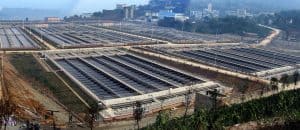
The construction cost is also favorably impacted by using common concrete walls, and rectangular configurations, contributing to overall cost savings for this design.
In addition to land efficiency, the even flow distribution configuration in rectangular clarifiers translates into simpler and less expensive pipe work layouts and pumping requirements.
These construction advantages are a notable contrast to circular clarifiers, where the pipes necessitate a more intricate layout pattern, potentially requiring a separate pumping station. Further, the nature of a network of circular clarifiers requiring larger footprints for the same surface area places them at a disadvantage in well-designed treatment facilities.
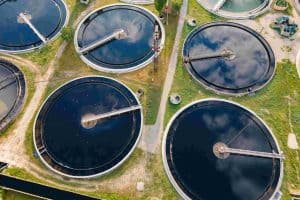
Considering the need for covers in many clarifiers for odor or volatile organic compound (VOC) control, rectangular clarifiers, particularly those using chain and flight systems, offer yet another advantage. The design and installation of covers for rectangular clarifiers are not only simpler but also more cost-effective.
Clarifier Operation and Maintenance
Operational and maintenance aspects of rectangular clarifiers are another area where advantages are seen, emphasizing efficiency and long-term reliability. The non-metallic chain and flight systems (like our Polychem system), featuring multiple flights installed at fixed spacing (typically 10 ft or 3 m), play a crucial role. These systems excel in achieving both sludge and scum removal, scraping the tank bottom to present consistent sludge flows to the hoppers.
In rectangular clarifiers, as the flights travel to the surface along the collector chain, the scum/foam is efficiently pulled to the scum trough, showcasing an effective trapping mechanism. This ease of scum and floating solids removal is a distinctive advantage associated with rectangular clarifiers.
In contrast, circular scraper systems, with only two rotating collector arms and multiple scrapers on each arm, follow a different approach. They plow settled sludge to a hopper at the center of the tank, and a single cantilevered skimmer arm rotates at the surface to collect scum. However, this method, involving a hinged skimmer and subsequent dragging up a scum beach and trough, presents challenges compared to the straightforward scum removal in rectangular clarifiers.
Operational Speed
Faster is not always better, especially when it comes to having to repeat the task at hand. While circular clarifiers may move sludge more quickly, that comes with a disadvantage.
The operational speed of non-metallic chain and flight systems in rectangular clarifiers, maintaining a constant speed of approximately 2 ft (600 mm)/min, ensures efficient sludge removal without risking re-suspension of settled solids.
Circular collectors, as mentioned earlier, move sludge at a faster rate at the perimeter than at the center, with scraper speeds greater than 6 ft (1800 mm)/min posing a risk of re-suspension.
Considerations for Large Collectors
In addressing challenges related to large collectors, rectangular clarifiers demonstrate superiority in scum control and the effectiveness of wind-blown mechanisms, especially in covered tanks. While historical concerns included the relatively frequent need to replace collector chains in rectangular clarifiers, advancements such as the implementation of non-metallic chains have significantly extended replacement frequencies.
Before the 1970s, replacements were required every 10-20 years, but after adopting non-metallic chains, the frequency was reduced to once every 15‐20 years.
Clarifier Lifecycle Cost
When evaluating the lifecycle costs of clarifiers, both rectangular and circular configurations fall within a similar range. However, a closer examination reveals that one does indeed come out ahead.
In terms of capital cost, encompassing clarifier equipment, civil expenses, and potential pump station costs, the rectangular configuration shines. It generally incurs lower initial expenses, contributing to a more cost-effective solution.
While circular clarifiers might boast lower operation and maintenance (O&M) costs, especially in mechanism replacement and maintenance, the overall lifecycle cost picture favors rectangular clarifiers. A case study of a 32 MGD new clarifier design in California exemplifies this. The total project capital cost for the rectangular configuration is 12% lower, even with a 50% higher yearly maintenance cost. The mechanism replacement frequency, estimated at every 10 years for rectangular and 20 years for circular, further supports the favorable lifecycle cost scenario for rectangular clarifiers.
These considerations highlight the strategic advantage of opting for rectangular clarifiers, as they offer a cost-effective solution not only in terms of capital investment but also in long-term lifecycle expenses
Summary
We’ve created a comprehensive overview of the advantages and considerations of both rectangular and circular clarifiers, from performance and reliability to operational efficiency and strategic cost considerations.
Performance and Reliability:
The adoption of non-metallic chain and flight systems makes rectangular clarifiers an intelligent choice, offering non-corrosive, low-maintenance solutions. With lightweight components and no need for routine lubrication, they ensure ease of installation and operational reliability. The absence of expensive cranes for routine maintenance further enhances their practicality.
Efficiency in Power Consumption:
Rectangular clarifiers exhibit a strategic advantage in power consumption, utilizing low-powered motors (0.5 kW). This not only ensures efficiency but also contributes to cost savings over time.
Consistent Flow for Optimal Pump Sizing
The design of rectangular clarifiers facilitates a consistent flow of sludge and scum, optimizing the efficiency of pump sizing. This operational advantage enhances overall performance and contributes to effective wastewater treatment processes.
Direct Comparison
Here is a direct comparison of strengths and weaknesses of each clarifier shape.
Rectangular Clarifiers:
- Longer, more linear flow path
- Extended hydraulic retention time (HRT) for efficient sludge settling
- Even flow distribution, minimizing head loss
- Consistent sludge removal at approximately 2ft/min
- Potential for reduced upfront costs, especially in multiple-unit designs
- Smaller footprint and efficient land use
Circular Clarifiers:
- Faster operational speed, but risk of re-suspension
- Potentially lower O&M costs, particularly in mechanism replacement
- Larger footprint and more intricate pipework layouts
Combined Considerations:
- Similar lifecycle costs, with a capital cost advantage for rectangular clarifiers
- Strategic cost reduction over the entire lifecycle for rectangular clarifiers
Rectangular vs Circular Clarifiers – Which One to Choose?
The choice between rectangular and circular clarifiers depends on the specific requirements of your water or wastewater treatment process, as always, but the advantages of rectangular are significant for many applications.
The experts at Brentwood understand this industry, and are standing by to answer your questions and help you make the best choice for your particular needs. Contact us today to learn more about our water & wastewater treatment solutions and other products and services
The shape of the rectangular clarifiers provides a longer path for the wastewater flow and the suspended solids to travel, and subsequently longer detention time which warrants less short circuiting and more sludge settling compared to the center‐feed/peripheral overflow circular clarifiers. In addition, flow distribution among several clarifiers is usually more even and often requires less head loss for rectangular clarifiers.
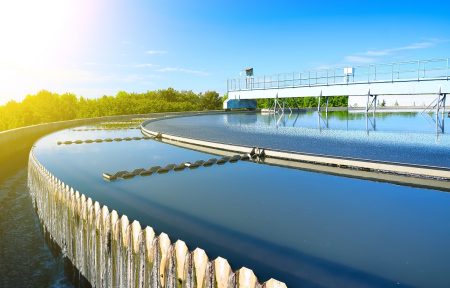
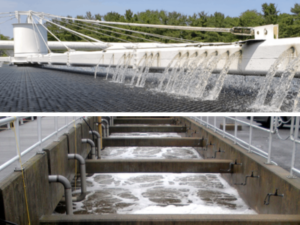
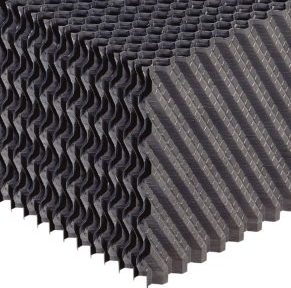
It’s interesting how you said that a rectangular clarifier might need a separate pumping station for its pipes. Being precautious and knowing exactly what you are going to need with a project would be important. That way you can be sure that you don’t have any problems down the line.
Rectangular clarifiers work well in a totally common wall facility. I have an idea for a nutrient removal process (10:10:5:3) that uses a single set of low head pumps that accomplishes RAS, WAS.,IR and FE. Rectangular clarifiers make this possible while lowering initial capital costs up to 40 percent and oparating costs up to 30 percent.
It’s interesting to know when you said that there would be a longer path for the wastewater flow when the shape is rectangular. I can imagine using the right wastewater design service would be a good investment for a property or a company to ensure that there will be no issues in that aspect. It will definitely be the best to work with professionals as well to make the right decisions.